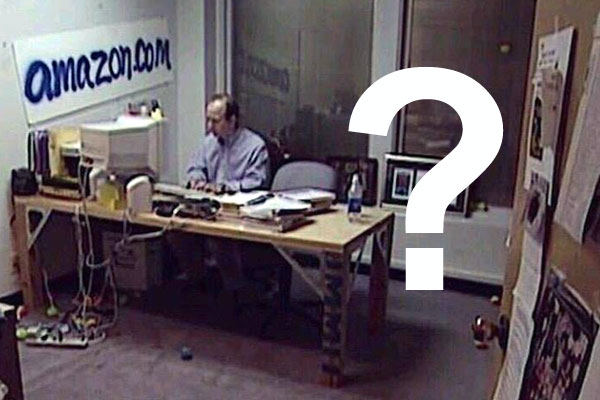Context is everything, especially on social media. There has been a lot of social media interest in the image above, less the question mark, combined with headings and comments like:
“Jeff Bezos in 1999. Next time you want to give up, think of this.”
“Jeff Bezos… Everyone starts somewhere. Keep going.”
“Jeff Bezos… Think about this the next time you think you can’t do something great.”
Jeff Bezos has recently been tagged as the world’s richest man (that we know of), which has led to new interest in his past, and in turn, the rise of this image. There he is, doggedly struggling in what looks like desperate obscurity, committed to his crazy new business idea. This is glorious, grainy self-help porn at its best. It’s beautiful, and not just because Bezos and his company have succeeded so brilliantly.
Except because of the way we use social media, the context of this image is missing and the message is not the one Bezos intended.
The image is actually a screen capture from a 1999 episode of CBS’s 60 Minutes titled, “Nerd of the Amazon”. So that explains the grainy part. At the time, Bezos was already a billionaire—an even more significant achievement in 1999 than it is today. He had left a high-paying Wall Street job to start something on his own. In 1994, that something became Amazon, and by 1999, it was worth $31bn [1]. The Bezos you see in the image had 7,500 employees. He also had the wherewithal to start his own space exploration company, Blue Origin [2], just one year later.
No, Jeff Bezos was not struggling on his own in 1999. He purposely made his Amazon office look like this. In his words:
“It’s a symbol of spending money on things that matter to customers, and not spending money on things that don’t.”
Bezos operates on what he calls a “regret minimization framework”. It requires a very long-term view on life and career, and the ability to trend-spot at the macro and micro levels. The World Wide Web appeared in the mid-1990s and Bezos was smart enough to immediately see it as “a critical category transformation time”—his category (at the time) being book retailing. The rest is history.
For the purposes of this post, let’s assume there’s nothing inherently wrong with the traditional American Dream message that social media is using this image to project: carpe diem to get started, work hard, stay with it no matter what [3]. Coincidentally, social media is also very carpe diem, in a figurative way. But for businesses big and small, I believe the originally-intended, full-context, old-school, long-form message is the better one:
Think hard before you start your new business. Match a well-considered current SWAT analysis for your product/service/company/category with a collaboratively-created and very long-term category trend analysis. The latter is even more important when truly disruptive technology is involved—creation of the WWW, etc. Repeat often, because context is everything.
The Full Context
- Based on market value in USD. Amazon’s IPO was in 1997, though it would not show sustained profitability until 2016. Coincidentally, 1999 was the dead-middle of the world’s first tech bubble, but that’s another story that the 60 Minutes episode touches on.
- Blue Origin was previously covered on this blog: TRUTH & TELLING FUTURE VISIONS.
- There is something wrong with the traditional American Dream message in this context, but that would be for another MW post, or better yet, another blog to pursue.





